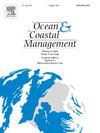Spatial-temporal effects on cargo throughput at Chinese ports: Insights from a multiscale geographically weighted regression approach
IF 5.4
2区 环境科学与生态学
Q1 OCEANOGRAPHY
引用次数: 0
Abstract
Port cargo throughput is a key indicator for evaluating port operations and economic development, playing a crucial role in national economic growth, trade activities, and urban development. Understanding the factors that affect port cargo throughput is crucial for optimizing port management and policy planning. This study uses a multiscale geographically weighted regression (MGWR) model to analyze the determinants of port cargo throughput. This study utilized data from 55 ports in China to discuss the independent variables that affect spatial distribution, including regional gross domestic product, investment in road and waterway construction, total import and export volume, total retail sales of consumer goods, number of port berths, and consumption expenditure of urban residents. The regression results of MGWR indicate that compared with the fixed bandwidth geographically weighted regression (GWR) model, the MGWR model with adaptive bandwidth provides better fitting. The innovation of MGWR model lies in solving the single bandwidth limitation of traditional GWR. From the perspective of time change, we collect panel data from 2018 to 2023, and add variables such as the domestic emission control area policy (DECA), the COVID-19, and the geographical location of the port (whether the port is located inland or coastal) to study the impact of these variables on port cargo throughput. The regression results indicate that regional gross domestic product, total retail sales of consumer goods invested in highway construction, number of berths, DECA, and whether the port is located inland or coastal have a significant impact on the port's cargo throughput. From a temporal and spatial perspective, the spatial pattern of changes in port cargo throughput has gradually shifted from being dominated by coastal ports to a coordinated development of coastal and inland ports.
中国港口货物吞吐量的时空影响:来自多尺度地理加权回归方法的见解
港口货物吞吐量是评价港口运行和经济发展的重要指标,对国家经济增长、贸易活动和城市发展具有重要作用。了解影响港口货物吞吐量的因素对于优化港口管理和政策规划至关重要。本研究采用多尺度地理加权回归(MGWR)模型分析港口货物吞吐量的影响因素。本研究利用中国55个港口的数据,讨论了影响空间分布的自变量,包括区域国内生产总值、道路水路建设投资、进出口总额、社会消费品零售总额、港口泊位数量和城镇居民消费支出。MGWR的回归结果表明,与固定带宽地理加权回归(GWR)模型相比,具有自适应带宽的MGWR模型具有更好的拟合效果。MGWR模型的创新之处在于解决了传统GWR的单一带宽限制。从时间变化的角度,我们收集了2018 - 2023年的面板数据,并加入了国内排放控制区政策(DECA)、新冠肺炎疫情、港口地理位置(港口位于内陆还是沿海)等变量,研究这些变量对港口货物吞吐量的影响。回归结果表明,区域国内生产总值、公路建设投资的社会消费品零售总额、泊位数量、DECA、港口位于内陆还是沿海对港口货物吞吐量有显著影响。从时间和空间上看,港口货物吞吐量变化的空间格局逐渐从以沿海港口为主转向沿海与内河港口协同发展。
本文章由计算机程序翻译,如有差异,请以英文原文为准。
求助全文
约1分钟内获得全文
求助全文
来源期刊

Ocean & Coastal Management
环境科学-海洋学
CiteScore
8.50
自引率
15.20%
发文量
321
审稿时长
60 days
期刊介绍:
Ocean & Coastal Management is the leading international journal dedicated to the study of all aspects of ocean and coastal management from the global to local levels.
We publish rigorously peer-reviewed manuscripts from all disciplines, and inter-/trans-disciplinary and co-designed research, but all submissions must make clear the relevance to management and/or governance issues relevant to the sustainable development and conservation of oceans and coasts.
Comparative studies (from sub-national to trans-national cases, and other management / policy arenas) are encouraged, as are studies that critically assess current management practices and governance approaches. Submissions involving robust analysis, development of theory, and improvement of management practice are especially welcome.
 求助内容:
求助内容: 应助结果提醒方式:
应助结果提醒方式:


